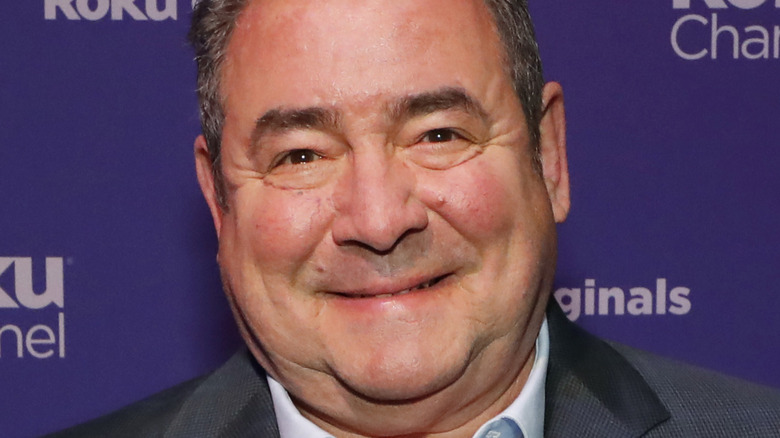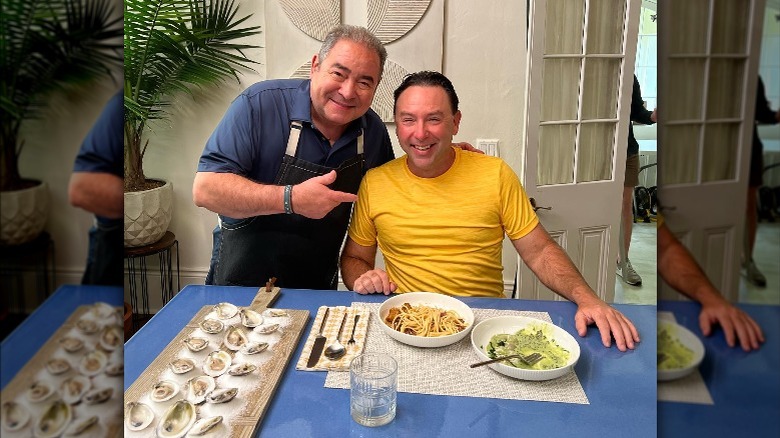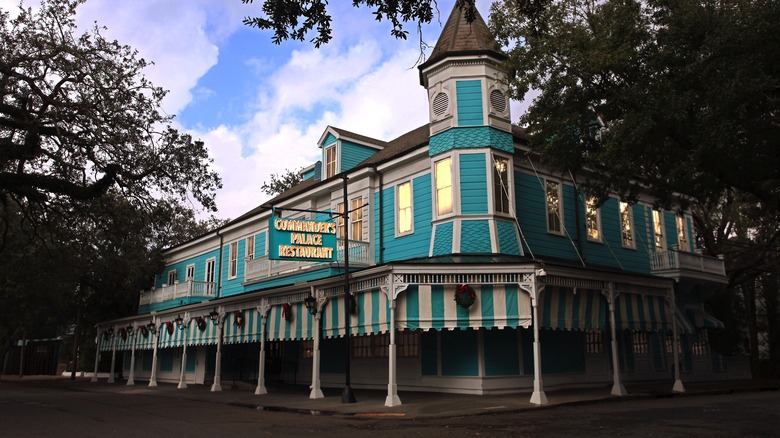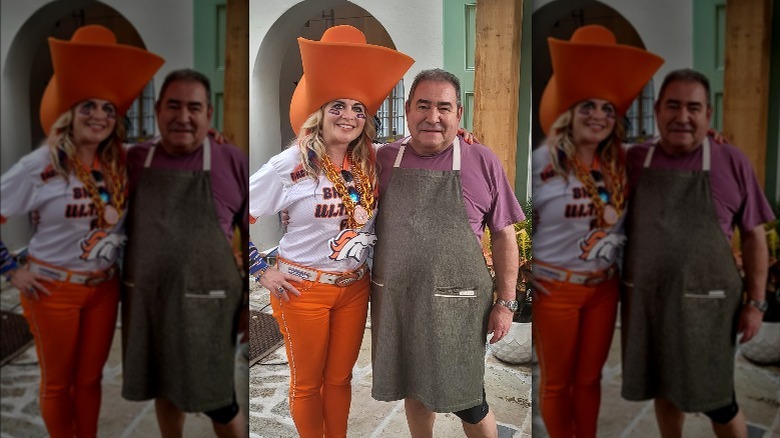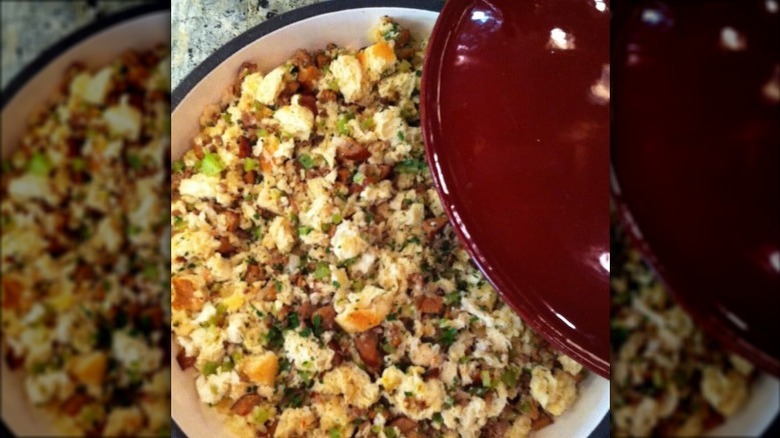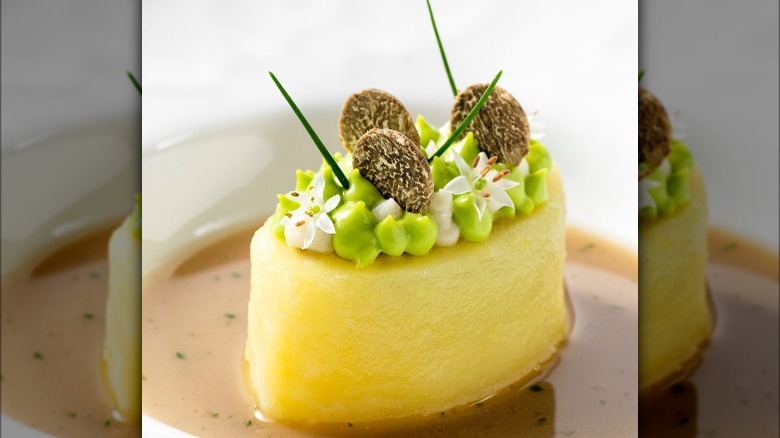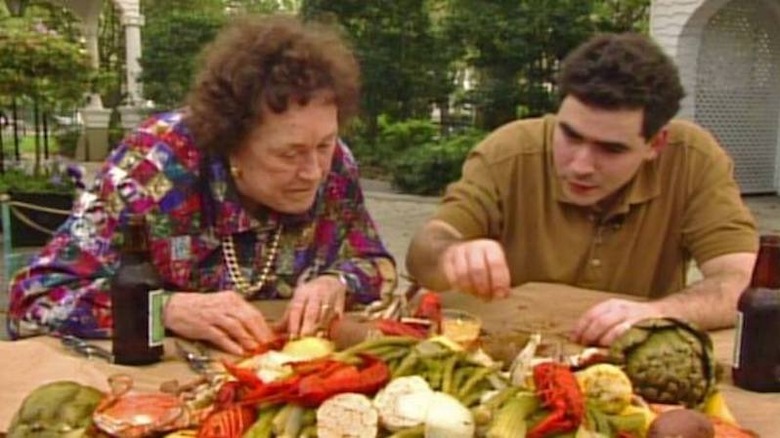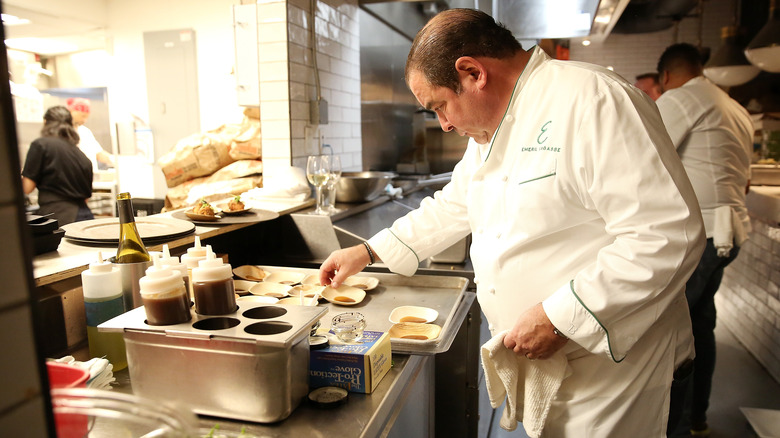Emeril Lagasse Gets Back To His Roots With Emeril Cooks - Exclusive Interview
The younger generation of culinary enthusiasts may be more familiar with the latest TikTok food influencer than Emeril Lagasse. But little do they know how this groundbreaking chef laid the foundation for the mainstream food media we all enjoy today. The Massachusetts-born turned New Orleans-bred chef made his Food Network debut in the early 1990s with "How to Boil Water" which led to the hit "Essence of Emeril." Then in 1997, "Emeril Live" made its triumphant debut, and with that, a culinary superstar was born, along with a whole new genre of food TV. Three decades later, the show lives on in the lexicon of iconic cooking shows, and chef Lagasse's career has expanded to include dozens of restaurants, cookbooks, product lines, and more, his name becoming a brand even bigger than the chef's persona.
And yet, many have noticed that Lagasse's TV presence has diminished in recent years (though not entirely). While the attention span of Food Network fans has moved on to the next celebrity chef and tournament of champions, chef Lagasse has still been busy running restaurants, managing businesses, and giving back through his foundation. He'd argue that, in many ways, he's returned to his roots, which are in the kitchen first and foremost, finessing the flavors that make him who he is, and throwing a "bam!" out there every now and then for good measure.
Now Lagasse is stepping in front of the camera once again, bringing folks into his kitchen for two new Roku shows. "Emeril Tailgates" which premiered in September 2022, takes a closer look at the tasty football gameday traditions in some of the top sports cities around the country, with Chef Lagasse presenting his creative take on regional recipes from coast to coast. "Emeril Cooks," which is now also available to stream on Roku, looks at some of the chef's traditional culinary inspirations in New Orleans, while also showcasing Lagasse's unique talent for pushing the limits of Louisiana cuisine.
Tasting Table got details on all this and more while catching up with Lagasse. In an exclusive interview, the chef opened up about his love for New Orleans cuisine, the culinary influences that shaped his career, and how he's preparing to carry on his legacy.
Emeril Cooks highlights everything Lagasse loves about New Orleans
"Emeril Cooks" is giving your fans a really unique insight into your culinary inspirations. What do you love most about Cajun and Creole cuisine?
Well, it is basically the foundation of Louisiana. You have Creole cooking, which is really sort of the city version of Louisiana cooking, and then you have what's been slang Cajun, but Acadiana, which is the country style. I have done both, in a more modern, classic way. That's really the foundation of what my food is.
And then I add ingredients and techniques of other cultures as well, and that's what "Emeril Cooks" really is. That's what it's all about, is adding those different cultures and techniques.
With "Emeril Tailgates," we had these super fans from all over the place that would come to New Orleans. With this show, a lot of the talent, a lot of the guests, are Louisiana grown. As an example, there's a young lady in the country a couple hours out of the city. She has a water buffalo farm. She grows water buffalos and she uses the milk to make gelato and to make cheese. Then, she uses the parts of the water buffalo, which we used on the show. It's really phenomenal.
There were these two ladies that really wanted to make sake in Louisiana, but ... you have to make sake with short grain rice. Louisiana's the third most popular rice state in the country, but we grow long-grain rice, not short-grain. Long story short, we show the educational part of the capital of rice in Louisiana. It's called Crowley. We show how, with [the help of] the University of Louisiana, we [grew] the short rice grain. These ladies began making Louisiana sake with Louisiana grain rice. It's phenomenal. It's really fantastic. We have them on. We cook the whole show. We're cooking with sake.
We had a gentleman on that's growing Louisiana oysters. After the hurricane, he got seedlings left and the whole process started in Grand Isle. Then we did a whole show about oysters and it's really, really, really an awesome show. It's really phenomenal.
Like Lagassa himself, NOLA cuisine is a timeless classic
What would you say has changed the most about New Orleans food culture in the last few decades?
Well, I think it's getting modernized a bit more. But the thing about Louisiana, it's one of the oldest cuisines in America, so there's only so much change that you can do before the barriers get totally broken. Those barriers really remain on taste and ingredients. I think that's what we really focus on with "Emeril Cooks." Particularly, moving forward for the next season of "Emeril Cooks," we're even really zoning in more on the shrimp person and the squash farmer and the mirlitons being grown. It's a lot of fun. It reminds me of "Essence of Emeril" on steroids.
And I love that it's so hyper-focused on how Louisiana food is the epitome of farm-to-table, which is something you've embraced throughout your entire career.
Yeah, thank you. Well, that's what we're trying to do. What we learned after doing the first season is that we're really going to zero in more on that, on what's really happening in the state, whether it's the shrimp person or the oyster person, or the person making this micro beer or making sake as an example. We're going to keep doing more of that.
What are some of your favorite spots to eat out at in New Orleans today?
I mean, you have the classics, Commander's Palace, of course, and Antoine's and Galatoire's. You have those New Orleans, I hate using the word institutions, but you have those places.
And then, there are places that are still growing strong. I love Frank Brigtsen. I love Susan Spicer. But then, there's these new chefs that are coming up, like the chefs at Saint-Germain, and there's a lot of new things that are happening.
Lagasse claims New Orleans can tailgate with the best of them
As you mentioned, "Emeril Cooks" comes on the heels of your other Roku show, "Emeril Tailgates." Do you have any favorite food tailgating traditions?
I do, actually. In Louisiana, you got your jambalaya. You got your red beans and rice. You got your po' boys.
What we do [on this show] is we use a super fan, say in Denver for the Broncos — this particular [episode], it was a lady — how she tailgates and what she tailgates and why she tailgates. A lot of it, too, which has been really cool, is that just about every one of these guests that we have has some sort of reason [for tailgating], community-related. Whether it's children or whether they're doing something for the community, most of them are all giving back. They do these tailgate things, some charge, some don't. It's really like a club. It's really cool.
I mean, Cleveland was fun. The guy that we had in Cleveland, we made pierogis. Just every one of them has been great as far as the tailgate show.
What city does tailgating the best, in your opinion?
That would be a huge argument, Alexandra, that you would have from people. Because Dallas thinks they do it better than New York and [The Jets] think that they're doing it better than the Giants. And then, New England has their thing. Everybody brings a little bit of different culture to it.
I think New Orleans is a great city for football because everything is so close. It's a great city for the Super Bowl because everything is so close. The hotels are close. The restaurants are close. Pretty much walking distance, so that makes it really easy. But there are some amazing stadiums out there now. This new stadium that just got built for the Raiders in Las Vegas is really awesome. The new stadium in Dallas, where the Cowboys are playing, I mean, state of the art. The new stadium in Minnesota, it's really cool. They just keep building them bigger and better.
What's on the Lagasse holiday menu
Moving into the holiday season, what are some of your favorite traditional holiday dishes?
I have to say that, during the holidays, the biggest influence is really my mom. Christmas Eve, I took a family tradition and put it into my restaurant in Emeril's Coastal, which is in the panhandle, and we do the Feast of the Seven Fishes. I was growing up with that. I don't know why it got the term seven fishes, because there was always more. I started doing that about three years ago at Emeril's Coastal. But I still do that at Christmas time at the house with family and a few friends. It's just something that's a tradition.
My mom's dressing, or stuffing, whatever you want to call it, is Portuguese dressing that she does called lache. That always has to be a must at Thanksgiving for sure.
What's in that?
It's Portuguese chorizo-based [with] the trinity: bell pepper, celery, onions. It's very simple. It's a bread stuffing. The key is that she soaks the bread. She uses milk, and then you sauté all [the veggies]. It's really delicious.
Oyster dressing in New Orleans would be a tradition. Crab and corn bisque would be a tradition in New Orleans. Cornbread dressing, for sure. Sweet potatoes, of course. You got to have good mashed potatoes and you got to have good gravy, right? No matter if it's Christmas or Hanukkah or Thanksgiving, you've got to have a good gravy.
Do you like a good Cajun spiced turkey?
I did one yesterday. Actually, it's the first time since the pandemic that I had the chance of doing the "Rachael Ray" show again. We were celebrating Thanksgiving, so I did this turkey roulade – which I'm kind of on a turkey roulade kick — where you [just cook] the breast. Everybody complains that the turkey's always dry, right? Because they're trying to cook the legs at the same time as they're doing the breast and the breast dries out but the legs, are they really cooked? And then, God knows about the wings, what's going on?
I started taking those off, cooking them separately. I take the legs off and you can either simmer them, and then you have turkey stock for your gravy, and then the legs are really nice and tender, or you can slow roast them in the oven. I've been taking the breast and sort of pounding it with plastic wrap a little bit. And then, I make whatever dressing I want to make, my mom's or, yesterday, I did a cornbread dressing with andouille sausage. And roll [the turkey up] and then tie it, sear it in a cast iron pan and then finish it in the oven to the right internal temperature. Then, you let it cool a little bit and you just take a slice of that, the roulade, and the stuffing is in the center. It's really delicious.
The dishes Legasse loves to prepare
You've developed countless recipes over the years. What's the one that you still get asked about the most?
At Emeril's, I think the dish that's excited people again is the retake and remake of Potato Alexa. It's this potato that's layered with a little bit of truffle and it has this truffle cream and it's really delicious. I think people would absolutely flip out if I didn't have my barbecue shrimp. It's not your typical barbecue. It's a New Orleans barbecue shrimp. People just go crazy for that. I'm doing this crab in lobster gumbo right now that's really delicious, in the salon. Really tasty.
As far as just personal in the house, again, I go back to my mom. Her caldo verde is people's favorite. Her Portuguese roast pork and clams are always great. I love seafood. Anything with seafood and fish, I'm there. Sign me up.
But I also love pasta. I like making it. I got this really simple little pasta machine that I'm using right now, [to] just crank out a bunch of different pastas in all different shapes. Fresh pasta's great. But then, I always find myself going back to the dry pasta too, because this is something that from growing up — [I'm] used to that dry pasta thing, particularly rigatoni, spicy rigatoni.
Lagasse looks back on the legacy of his mentor Julia Child
I was recently re-watching some "Emeril Live" episodes with Julia Child. She was just so infectious, and she was such a hoot. Do you recall taping those?
I do. Julia was a great friend. She came on "Emeril Live," I think maybe three times. Once we did burgers. Another time we did an apple tartine. The thing about Julia is that, besides being a character and one of the greatest ladies on the planet, she always had to give me some sort of feedback. That's just Julia.
She asked me to do "Cooking with Master Chefs" and cover New Orleans. I made her etouffée and I also taught her how to eat crawfish. I don't know if you've ever had crawfish, but there's an art to sucking head and pinching tail. I have the pleasure of telling people that I taught Julia Child how to do that. We had a ball. It was absolutely one of the best afternoons I could imagine when we did a crawfish boil.
You've also mentioned in previous interviews that she's actually a big reason that you got into TV. How did she influence your career?
I remember, as a young boy, that I would watch her show. I watched her and I watched "The Galloping Gourmet," but it was Julia that really gave me the influence. I think it was because of her style. Julia was just Julia and stuff happens. I'm being polite about that, but stuff happens, and that was her approach about doing that. I remember taking that in — that sometimes when you're cooking, not everything is perfect. Or you drop something on the floor or a carrot rolls off the countertop, things happen. That was one of the things that I learned from her was that you just got to go with the flow.
And then there was always an educational perspective of her show that was important to her, of trying to teach people. At the time, she was trying to teach people French cooking and she was trying to get women in this country to be [less] intimidated about French food, and that stuck with me. When I created any shows like "Essence of Emeril" or "Emeril Live," it was always very important [to have] an educational thing. It always had to be something for everybody, whether they were a novice cook or whether they were even a professional cook. You had to have fun.
A lot of the beginning days of "Emeril Live," it got a lot of criticism because maybe I was having too much fun, but that's what I was bringing out. And then, there was never a script. It was basically a live audience, the band, which was a music connection with me. I just went about it that way, trying to educate people and take the intimidation factor out of it so that people get excited about cooking instead of being intimidated about cooking.
Why Lagasse never hosted a food competition show
And as someone who was one of the early pioneers of this mainstream food TV that we still enjoy today, what are your thoughts on how this landscape has evolved?
Well, TV's changed a lot. When I ended "Emeril Live," there was a short time and then, all of a sudden, this competition cooking, if you will, emerged. Everybody wanted to do a competition show. I didn't want to do a competition show. I'm a guest judge on a few of them. But to do one 24/7, that's not really my style to want to do that because, again, I go back to: Where's the educational factor other than seeing somebody flub or see somebody do something beautiful? That was one arena that changed, still lingered on, still is on.
And then, TV dollars changed. A lot of these big companies, marketing companies, they weren't spending the marketing dollars that they needed. And so, that really changed the course of how programming was going to be accounted for in TV.
For me, I'm really zeroed in on my restaurants. That's really where I want to be. That's where I spend most of my time these days, other than taking short times to do the Roku show, which we shot in New Orleans, by the way, both of them. It was close to home, so it was just a five minute drive, not a plane ride. I could get things done quick and then still be at the restaurant.
The restaurant, particularly the flagship, is really evolving. Now, I have my son. Slowly, slowly, he's become the chef patron now of Emeril's. He's got good training. He went to school and grew up in the business. He had some very, very good mentors. Eric Ripert at Le Bernardin. Daniel Boulud. He went to Europe. He studied in Europe. He worked for Clare Smyth at Core. He worked in France and he really got some good training. Now, he's recently been back and, together with our team, we're slowly just sort of evolving the restaurant to another level.
Just for fun, how often these days do you catch yourself saying "bam"?
Not a lot. I did the "Rachael Ray" show yesterday. Of course, the audience was totally wanting it, so I gave them one. But it's not something that I'm walking around or running around, whatever, saying "bam."
It's an occasion thing. It was a thing of then. How that all came about was, "bam" was really about keeping people up and keeping them awake because we had a very, very brutal schedule. Being a food show, they would eat and then we'd start losing people, the camera guys. "Bam" was really to wake people up.
Watch Emeril Lagasse's newest shows, "Emeril Cooks" and "Emeril Tailgates," available exclusively on the Roku Channel. And visit chef Lagasse's website to learn more about his restaurants.
This interview was edited for clarity.
